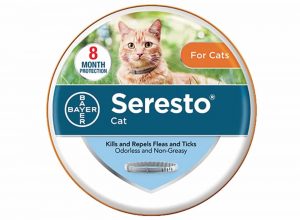Cat Flea Collars: Safety Tips and What to Consider

All featured products are chosen at the discretion of the GreatPetCare editorial team and do not reflect a direct endorsement by the author or reviewer.
Picture this: You’re on your couch, ready to catch up on your favorite TV show, and your cat hops up on your lap for snuggles. Sounds like a nice evening, right? That is until your kitty suddenly turns her head and begins frantically itching, licking or biting herself. Your heart sinks. Could she have fleas?
The truth is, fleas are incredibly common, especially the type known as the “cat flea” (aka Ctenocephalides felis). Cat fleas love to live on cats (and dogs) and they can affect both indoor and outdoor kitties. All a flea has to do to get inside your home is hitch a ride on another pet or your pant leg — and they can reproduce pretty quickly, leading to an infestation. Since fleas are good at hiding in your kitty’s fur, you might not notice until it becomes a bigger problem, such as if your cat has an allergic reaction that causes intense itching, redness, fur loss, or crusts. Cats can also get tapeworm from accidentally ingesting an infected flea while grooming, and kittens or senior cats with severe infestations may be at risk of flea-induced anemia.
If you notice fleas or flea eggs on your cat, black specks in their fur (known as “flea dirt”), or get bites yourself, try not to panic. While veterinarian-prescribed oral or topical flea treatments are the safest and most effective option, there are over-the-counter remedies that can also be beneficial.
What Are Cat Flea Collars?

Cat flea collars are collars that are made of materials like plastic or silicone that release a chemical or essential oil over time that repels or kills fleas.
“They are different from other flea treatments because they are a passive form of treatment,” explains Amy Davis, veterinarian. “They can also be used in conjunction with other forms of flea treatment for an increased level of protection.”
Flea collars can be appropriate for most cats—with some brands even being appropriate for kittens over 12 weeks old or senior cats. Read the label to make sure the collar you get is appropriate for your cat’s age. You might also want to check with your vet before choosing a collar, especially if your cat has a specific health condition.
How Do Cat Flea Collars Work?

Though it depends on the type of cat flea collar you get and the ingredients it contains, cat flea collars generally work in one of three ways:
- They release a chemical that kills fleas
- They release a chemical that repels fleas
- They release a chemical that interferes with flea egg development
Some cat flea collars will work in a combination of ways against multiple life stages of fleas, killing eggs and adult fleas to give your kitty more thorough protection. However, some flea collars only affect fleas a short distance from the collar.
Additionally, there can be health risks associated with flea collars. Some flea collars contain chemicals, such as organophosphates, that can result in serious signs of toxicity in cats. Others may contain essential oils that can cause reactions in some cats. Therefore, it’s important to do your research.
The Seresto flea collar for cats is most commonly recommended by veterinarians, due to its efficacy and low risk of harmful side effects. A 2021 investigative report raised some safety concerns about Seresto collars, but they are generally regarded as the safest over-the-counter flea collar option. The formula is effective against fleas, flea larvae, and ticks—and it lasts up to eight months. It starts to repel and kill fleas within 24 hours and ticks within 48 hours of initial application.

Are Flea Collars Safe for Cats?

Flea collars should be used with caution in cats. While the risk associated with a Seresto collar is relatively low, other over-the-counter feline flea collars contain essential oils or organophosphates that can be toxic in cats. In general, your best option for safe and effective flea control comes from veterinarian-prescribed flea preventatives for cats.
If you elect to use an over-the-counter flea collar, read and follow the directions on the label carefully. Do not use a dog flea collar on your cat, for example, as canine flea collars often contain pesticides that are toxic to cats. You’ll also want to make sure that you don’t put the collar on too loosely or too tightly, and that it has a breakaway feature to prevent accidental strangulation.
If your cat tends to chew on things, you’ll also want to be careful. “Some collars contain pesticides that can be harmful to cats if they lick or bite their fur after it’s been put on,” explains Davis. “These collars can [also] be harmful to cats if they chew on them, so it’s important to make sure your cat doesn’t chew on the collar.”
Some cats also have sensitive skin or are allergic to certain ingredients. If your cat has sensitivities or starts developing a rash after wearing the collar, discontinue using it.
Tetrachlorvinphos is an example of an organophosphate found in certain cat flea collars that may cause signs of toxicity in some cats, as well as in young children who touch the collar. Signs of toxicity to watch for include vomiting, diarrhea, muscle tremors, and paralysis. If you noticed any of these signs, remove the collar and contact your veterinarian immediately.
Shopping for a Cat Flea Collar: What to Look For

When you’re shopping for a cat flea collar, there are a few things to consider.
Active ingredients: First, take a look at the active chemicals. Collars that contain pesticides are generally highly effective at killing fleas and working against active infestations. However, as noted earlier, they are associated with risks of toxicity. Other collars are made with essential oils, which work by repelling the fleas. However, essential oils can also be very irritating to cats, so check with your veterinarian.
Durability: Second, make sure the collar is durable and will last a while. This will help you get the most use out of the collar for the money you spend on it.
Safety: Third, make sure the collar has safety features for your kitty, like a breakaway feature to prevent accidental strangulation.
Using Cat Flea Collars: Tips and Advice

Make sure that your cat is wearing their flea collar properly. “Collars should be worn high up on their neck, behind the ears, so that they come into contact with as much skin as possible,” says Davis. You’ll also want to make sure that the collar fits correctly. If you can’t fit two fingers under the collar, it’s on too tightly, but if the collar can easily slip off your cat’s head, it’s too loose.
To make the collar more effective, your cat should wear it for at least eight hours a day. Even though some collars are water-resistant, you might want to remove the collar while bathing your cat.
Finally, monitor your cat closely when using any new over-the-counter flea treatment. While serious toxicities are relatively uncommon, they can certainly occur. The sooner you detect signs of toxicity, the sooner your cat can receive veterinary treatment.









